Performance Prediction and Analysis of Solar-Assisted Ground-Source Heat Pump Systems in Typical Rural Areas, China
Abstract
1. Introduction
2. System Description
2.1. Target Building Description
2.2. Coupled System Description
3. Simulation System and Operational Strategies
3.1. Simulation System Introduction
3.2. Operational Strategies
3.2.1. Solar Collector Loop
3.2.2. Domestic Hot Water Loop
3.2.3. Borehole Heat Exchanger Loop and Ground-Source Heat Pump Loop
4. Results and Discussion
4.1. Energy Consumption of Ground-Source Heat Pump
4.2. Energy Consumption of Electric Auxiliary Heating
4.3. Total Energy Consumption
4.4. Heat Extraction of Borehole Heat Exchanger
4.5. COP of Ground-Source Heat Pump
4.6. Summary of Results and Comparison
5. Conclusions
- (1)
- The introduction of solar energy has reduced the energy consumption of various components within the heating system. As the area of solar collectors increases (from 15 m2 to 25 m2), the overall energy consumption of the system decreases significantly, with a maximum reduction of up to 20%. However, the increase in the number and depth of borehole heat exchangers results in an opposite trend in the energy consumption of the GSHP and the electric auxiliary heating within the DHW tank.
- (2)
- Utilizing surplus solar energy for ground thermal reinjection during the non-heating seasons can solve the problem of ground thermal attenuation and ensure the relatively stable heat extraction rate of the BHE. For the Beijing system, after 20 years of operation, there will be an increase in heat extraction, with the highest growth rate reaching 0.60%. Due to the higher load in the Changchun system, the selected cases still experienced a decline in heat extraction after long-term operation. However, compared to the cases without thermal reinjection, the rate of decline in heat extraction decreased from 2.00% to 1.44%.
- (3)
- Increasing the solar collector area, the number and the depth of boreholes all contribute to the improvement of the heat pump’s COP. However, the increment of the efficiency decreases as these factors increase. Therefore, selecting system design parameters reasonably can achieve a relatively higher efficiency of the heat pump while keeping other operational parameters within optimal ranges and controlling reasonable investment costs.
- (4)
- Based on the comprehensive analysis of results from each case, three optimal conditions are selected for both Beijing and Changchun systems. A comparison with a single GSHP system indicates that for 20 years of operation for the Beijing system, the optimal condition (H = 150 m, n = 1, and A = 25 m2) of the coupled system reduces energy consumption by 57.32% (approximately 60 MWh), equivalent to saving 7.37 t of standard coal. For the Changchun system (H = 250 m, n = 1, and A = 25 m2), the energy consumption savings can reach 70 MWh, equivalent to 8.60 t of standard coal. Additionally, the total cost over 20 years decreases by 48.20% and 33.77% in Beijing and Changchun systems, respectively.
Author Contributions
Funding
Data Availability Statement
Conflicts of Interest
Nomenclature
| a | Electricity price (CNY/kWh) |
| A | Solar collector area (m2) |
| Cc | Solar collector cost (CNY) |
| Cd | Drilling cost (CNY) |
| CI | System initial investment (CNY) |
| CO | System operating electricity cost (CNY) |
| Cp | Pipeline laying cost (CNY) |
| Ctotal | System total cost (CNY/20 years) |
| H | Depth of boreholes (m) |
| n | Number of boreholes |
| PAUX | Energy consumption of electric auxiliary heating (kWh) |
| PGSHP | Energy consumption of ground-source heat pump (kWh) |
| Ppump | Energy consumption of circulating pump (kWh) |
| tDHW | Temperature of the domestic hot water tank (°C) |
| ts | Outlet temperature of the solar collector (°C) |
| tT | Temperature of the thermal storage tank (°C) |
| Abbreviations | |
| BHE | Borehole heat exchanger |
| COP | Coefficient of performance |
| DHW | Domestic hot water |
| GSHP | Ground-source heat pump |
| SAGSHP | Solar-assisted ground-source heat pump |
References
- Bakhyt, B.; Aimankul, Y.; Biken, N.; Gulmira, A. Current state and problems of alternative energy development in the world. E3S Web Conf. 2020, 159, 07004. [Google Scholar]
- Yang, R.T.; Wang, F.Q.; Rao, Z.H.; Shen, C.; Li, D. Advancing Sustainable Energy Solutions: Innovations in Clean Energy Applications and Conventional Energy Efficiency Upgrade. Energies 2024, 17, 2441. [Google Scholar] [CrossRef]
- Sierra, J.C.; Goncalves, A.P.; Silva, C.S. Using Urban Building Energy Models for the Development of Sustainable Island Energy Systems. Energies 2024, 17, 3135. [Google Scholar] [CrossRef]
- Lind, J.; Möllerström, E.; Averfalk, H.; Ottermo, F. Energy flexibility using the thermal mass of residential buildings. Energy Build. 2023, 301, 113698. [Google Scholar] [CrossRef]
- Diba, K.M.; Kristen, C.; Ulrike, P.; Anne, K.; Cristina, P. Identifying rural high energy intensity residential buildings using metered data. Energy Build. 2023, 298, 113604. [Google Scholar]
- Nie, J.; Pang, Y.; Wang, C.; Zhang, H.; Yin, K. Theoretical Study on the Relationship of Building Thermal Insulation with Indoor Thermal Comfort Based on APMV Index and Energy Consumption of Rural Residential Buildings. Appl. Sci. 2021, 11, 8565. [Google Scholar] [CrossRef]
- You, Z.J.; Torrejon, M.D.B.; Danzer, P.; Nouman, A.; Hemmerle, C.; Tzscheutschler, P.; Goebel, C. Cost-effective CO2 abatement in residential heating: A district-level analysis of heat pump deployment. Energy Build. 2023, 300, 113644. [Google Scholar] [CrossRef]
- Xu, J.; Gao, W.; Huo, X. Analysis on energy consumption of rural building based on survey in northern China. Energy. Sustain. Dev. 2018, 47, 34–38. [Google Scholar]
- Ma, Z.D.; Zhang, Y.P.; Saw, L.H.; Cui, X.; Jia, G.S.; Jin, L.W. Investigation on local geothermal energy attenuation after long-term operation of ground heat exchanger with considering aquifer effect. Geothermics 2023, 107, 102608. [Google Scholar] [CrossRef]
- Sanzana, T.; Tanvin, R.; Ul, A.I.; Sumayya, R.; Roy, D.; Shidharth, R.; Naeem, M.; Nafiu, N.; Eklas, H. Solar Energy in the United States: Development, Challenges and Future Prospects. Energies 2021, 14, 8142. [Google Scholar] [CrossRef]
- Jia, G.S.; Wang, Y.S.; Zhang, P.F.; Tao, Z.Y.; Ma, C.F.; Cheng, C.H.; Jin, L.W. Long-term performance optimization of medium-deep geothermal heat exchangers for building heating based on a project in Xixian New Area, China. Energy Build. 2024, 320, 114642. [Google Scholar] [CrossRef]
- Miocic, J.M.; Schleichert, L.; Van de Ven, A.; Koenigsdorff, R. Fast calculation of the technical shallow geothermal energy potential of large areas with a steady-state solution of the finite line source. Geothermics 2024, 116, 102851. [Google Scholar] [CrossRef]
- Luo, J.; Zhang, Q.; Liang, C.M.; Wang, H.Q.; Ma, X.N. An overview of the recent development of the Ground Source Heat Pump (GSHP) system in China. Renew. Energy 2023, 210, 269–279. [Google Scholar] [CrossRef]
- Yu, L. Development Model and Analysis of Single Well Circulating Shallow Geothermal Energy Based on Mathematical Modeling. Mater. Sci. Eng. 2020, 735, 012065. [Google Scholar] [CrossRef]
- Du, D.S.; Li, Y.Q.; Wang, K.P.; Zhao, Y.Z.; Hu, Z.Y.; Zhang, W.D.; Wang, Q.L. Experimental and numerical simulation research on heat transfer performance of coaxial casing heat exchanger in 3500m-deep geothermal well in Weihe Basin. Geothermics 2023, 109, 102658. [Google Scholar] [CrossRef]
- Wu, W.; You, T.; Wang, B.; Shi, W.; Li, X. Evaluation of ground source absorption heat pumps combined with borehole free cooling. Energy Convers. Manag. 2014, 79, 334–343. [Google Scholar] [CrossRef]
- Zhang, Z.B.; Tao, Z.Y.; Ma, Z.D.; Jia, G.S.; Saw, L.H.; Jin, L.W. Performance prediction and analysis of a solar assisted medium-deep geothermal heating system. IOP Conf. Ser. Earth Environ. Sci. 2024, 1372, 12008. [Google Scholar] [CrossRef]
- O’Shaughnessy, E.; Cutler, D.; Ardani, K.; Margolis, R. Solar plus: A review of the end-user economics of solar PV integration with storage and load control in residential buildings. Appl. Energy 2018, 228, 2165–2175. [Google Scholar] [CrossRef]
- Mo, Z.L.; Wang, D.J.; Zhang, R.C.; Yu, Z.X. Optimization of solar heating systems for office buildings in solar enriched areas with Time-zoned heating strategy. Appl. Therm. Eng. 2024, 256, 124021. [Google Scholar] [CrossRef]
- Joshi, S.S.; Dhoble, S.A. Photovoltaic-Thermal systems (PVT): Technology review and future trends. Renew. Sustain. Energy Rev. 2018, 92, 848–882. [Google Scholar] [CrossRef]
- Yan, R.; Yu, X.; Lu, F.; Wang, H. Study of operation performance for a solar photovoltaic system assisted cooling by ground heat exchangers in arid climate, China. Renew. Energy 2020, 155, 102–110. [Google Scholar]
- Nouri, G.; Noorollahi, Y.; Yousefi, H. Solar assisted ground source heat pump systems—A review. Appl. Therm. Eng. 2019, 163, 114351. [Google Scholar] [CrossRef]
- Li, H.; Sun, L.; Zhang, Y. Performance investigation of a combined solar thermal heat pump heating system. Appl. Therm. Eng. 2014, 71, 460–468. [Google Scholar] [CrossRef]
- Sun, C.; Ju, X.L.; Hao, W.G.; Lu, Y.F. Research on multi-objective optimization of control strategies and equipment parameters for a combined heating system of geothermal and solar energy in cold and arid regions based on TRNSYS. Case Stud. Therm. Eng. 2024, 256, 124021. [Google Scholar] [CrossRef]
- Zhang, J.; Tang, J.R.; Niu, C.; Chen, Z.Q. Design and characterisation of geothermal and solar multi-energy complementary heating system. J. Build. Eng. 2025, 103, 112052. [Google Scholar] [CrossRef]
- Weeratunge, H.; Narsilio, G.; Hoog, J.D.; Dunstall, S.; Halgamuge, S.; Thygesen, R.; Karlsson, B. Model predictive control for a solar assisted ground source heat pump system. Energy 2018, 152, 974–984. [Google Scholar] [CrossRef]
- Thygesen, R.; Karlsson, B. Economic and energy analysis of three solar assisted heat pump systems in near zero energy buildings. Energy Build. 2013, 66, 77–87. [Google Scholar] [CrossRef]
- Ballerini, V.; Schio, E.R.D.; Valdiserri, P.; Naldi, C.; Dongellin, M. A Long-Term Dynamic Analysis of Heat Pumps Coupled to Ground Heated by Solar Collectors. Appl. Sci. 2023, 13, 7651. [Google Scholar] [CrossRef]
- Putrayudha, A.S.; Kang, C.E.; Evgueniy, E.; Evgueniy, E.; Lee, J.E. A study of photovoltaic/thermal (PVT)-ground source heat pump hybrid system by using fuzzy logic control. Appl. Therm. Eng. 2015, 89, 578–586. [Google Scholar] [CrossRef]
- Streimikiene, D.; Baležentis, T.; Volkov, A.; Morkūnas, M.; Žičkienė, A.; Streimikis, J. Barriers and Drivers of Renewable Energy Penetration in Rural Areas. Energies 2021, 14, 6452. [Google Scholar] [CrossRef]
- Liang, Y.; Wang, D.; Li, Y.; Zhang, Q.; Suo, B.; Yuan, X.; Liu, Y. Novel approach to remote rural heating: Direct coupled photovoltaic electric heater underfloor heating system with phase change materials. Appl. Therm. Eng. 2024, 250, 123525. [Google Scholar] [CrossRef]
- Tang, F.; Nowamooz, H. Factors influencing the performance of shallow Borehole Heat Exchanger. Energy Convers. Manag. 2019, 181, 571–583. [Google Scholar] [CrossRef]
- Walch, A.; Mohajeri, N.; Gudmundsson, A.; Scartezzini, J. Quantifying the technical geothermal potential from shallow borehole heat exchangers at regional scale. Renew. Energy 2021, 165, 369–380. [Google Scholar] [CrossRef]
- Zou, H.; Guo, S.; Wang, R.; Wang, F.; Shen, Z.; Cai, W. Numerical investigation of the long-term load shifting behaviors within the borehole heat exchanger array system. Energies 2023, 16, 2497. [Google Scholar] [CrossRef]
- Lei, X.; Hu, S.; Li, J.; Jiang, G.; Yang, Q.; Li, Q. Characteristics of heat flow and geothermal distribution in the northwest Beijing plain. Chin. J. Geophys. 2018, 61, 3735–3748. (In Chinese) [Google Scholar]
- Sazon, T.A.; Zhang, Q.; Nikpey, H. Comparison of different configurations of a solar-assisted ground-source CO2 heat pump system for space and water heating using Taguchi-Grey Relational analysis. Energy Convers. Manag. 2024, 300, 117881. [Google Scholar] [CrossRef]
- Pu, L.; Qi, D.; Xu, L.L.; Li, Y.Z. Optimization on the performance of ground heat exchangers for GSHP using Kriging model based on MOGA. Appl. Therm. Eng. 2017, 118, 480–489. [Google Scholar] [CrossRef]
- Nhut, L.M.; Raza, W.; Park, Y.C. A Parametric Study of a Solar-Assisted House Heating System with a Seasonal Underground Thermal Energy Storage Tank. Sustainability 2020, 12, 8686. [Google Scholar] [CrossRef]



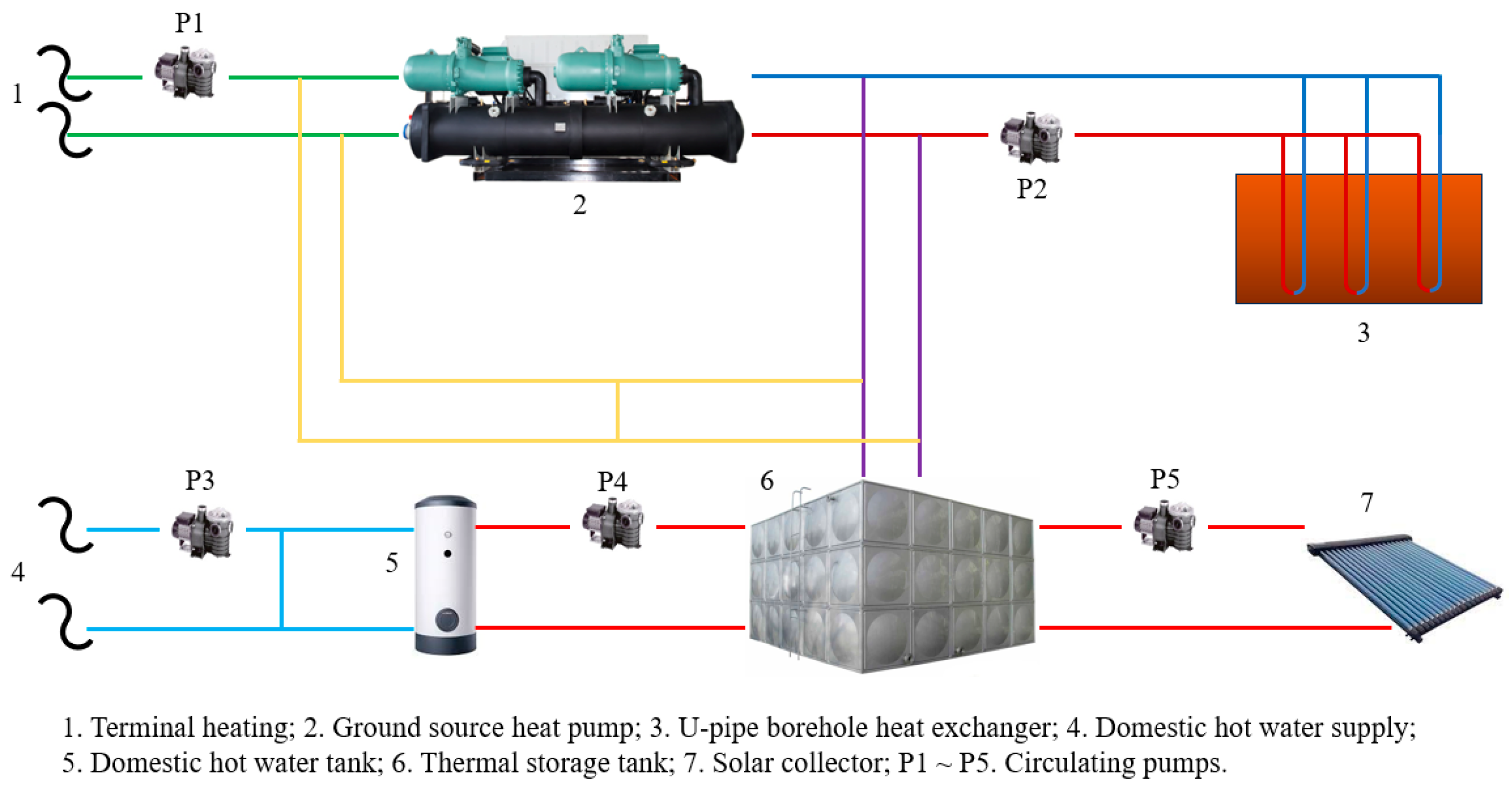




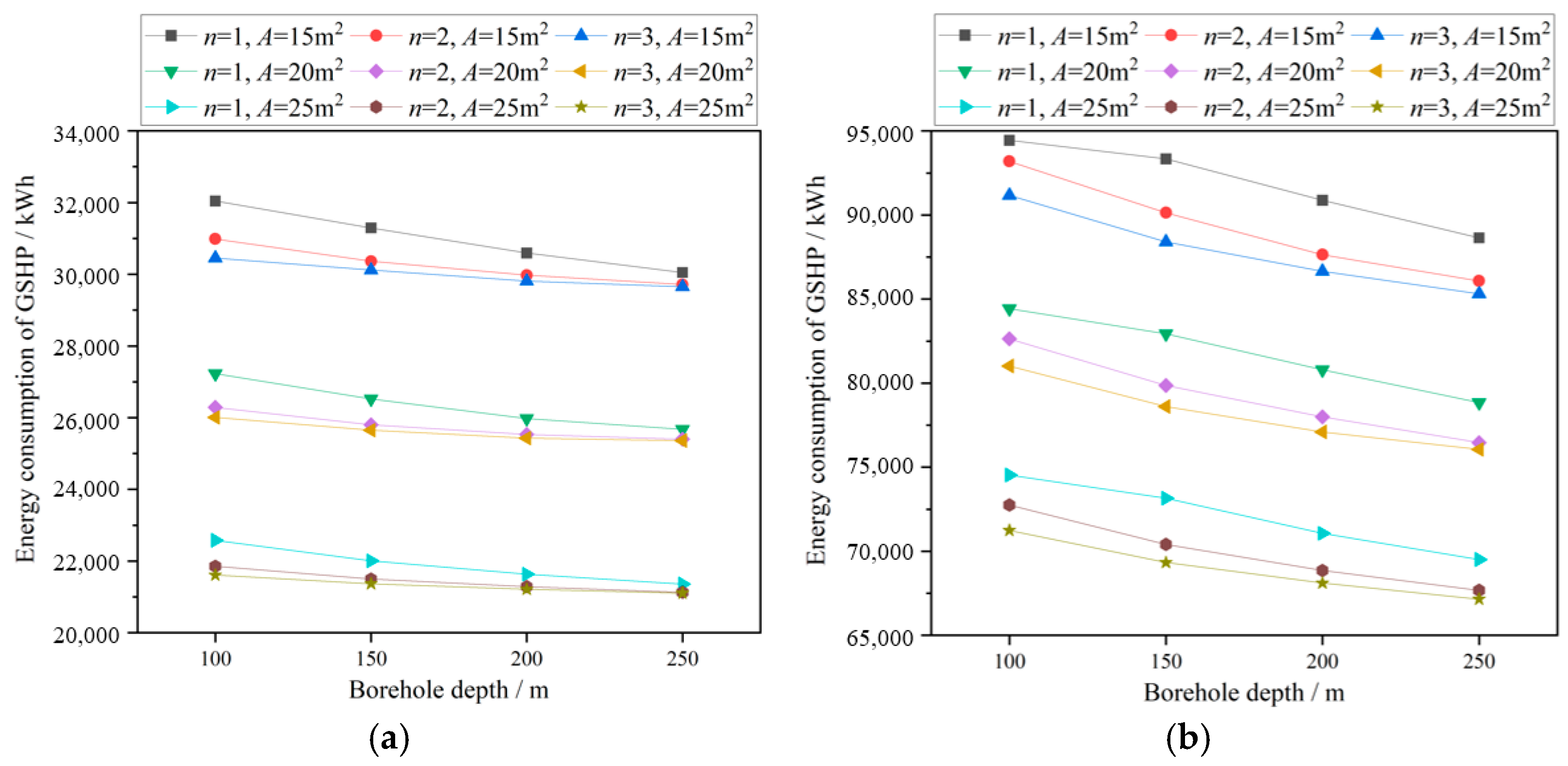


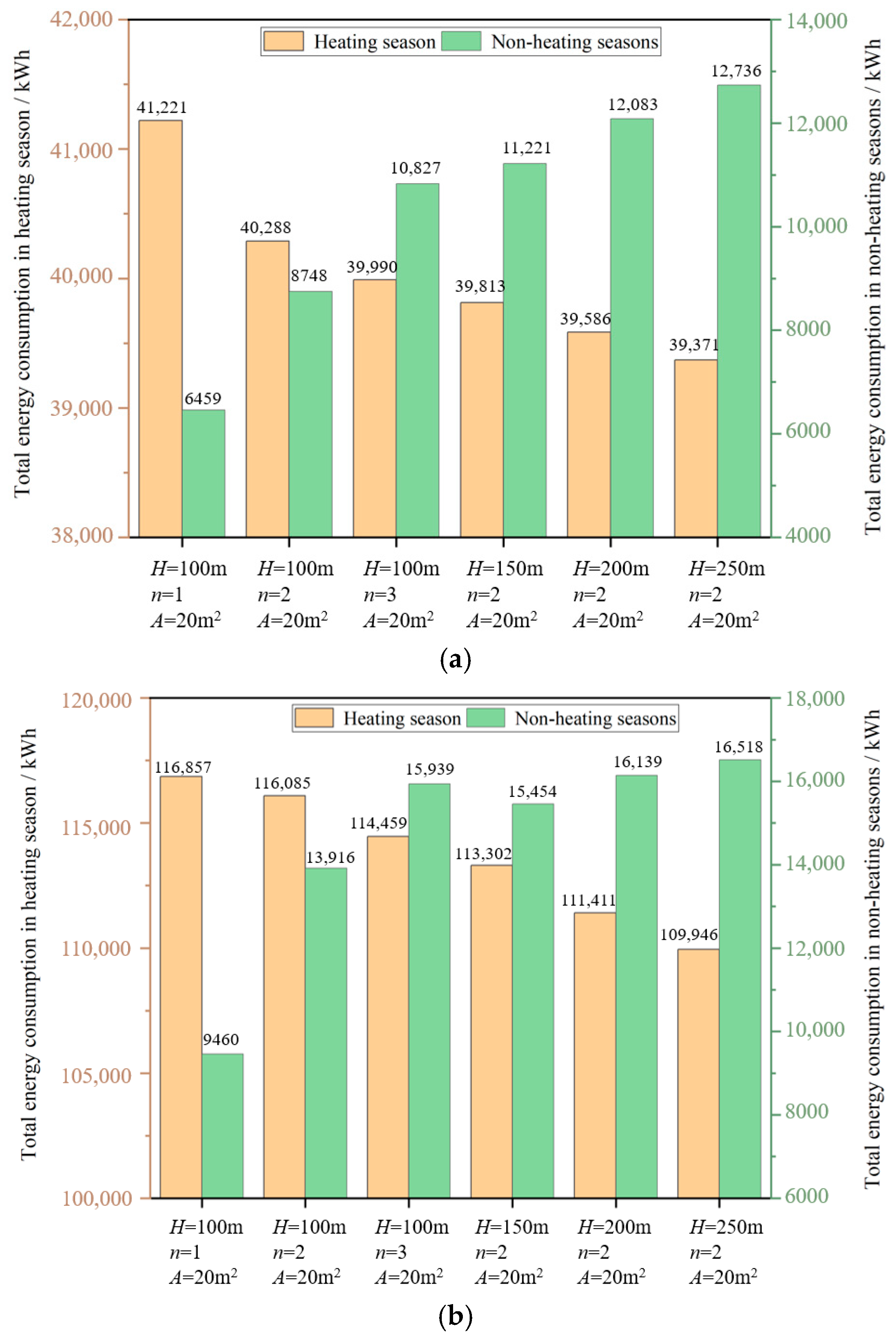
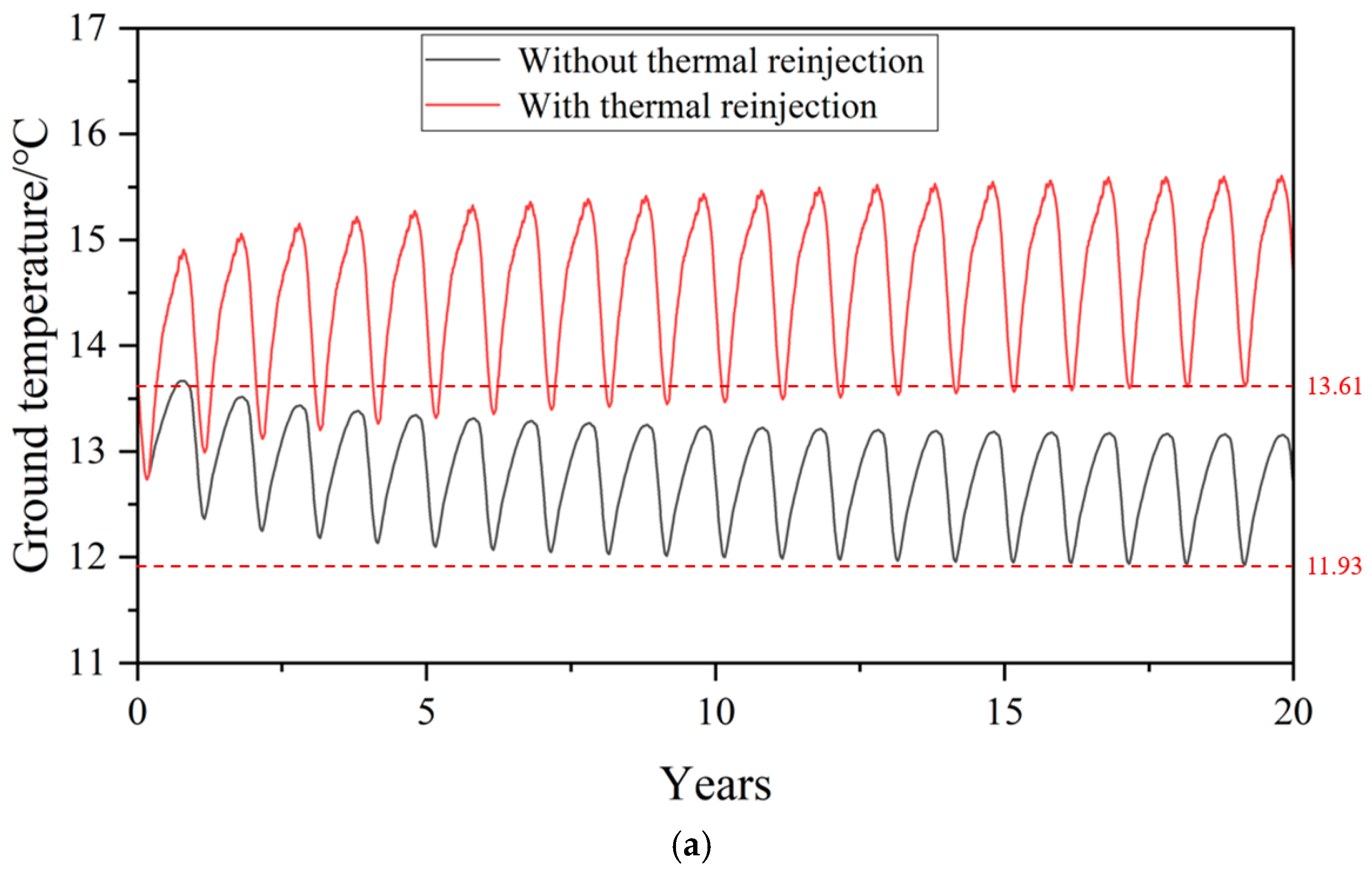


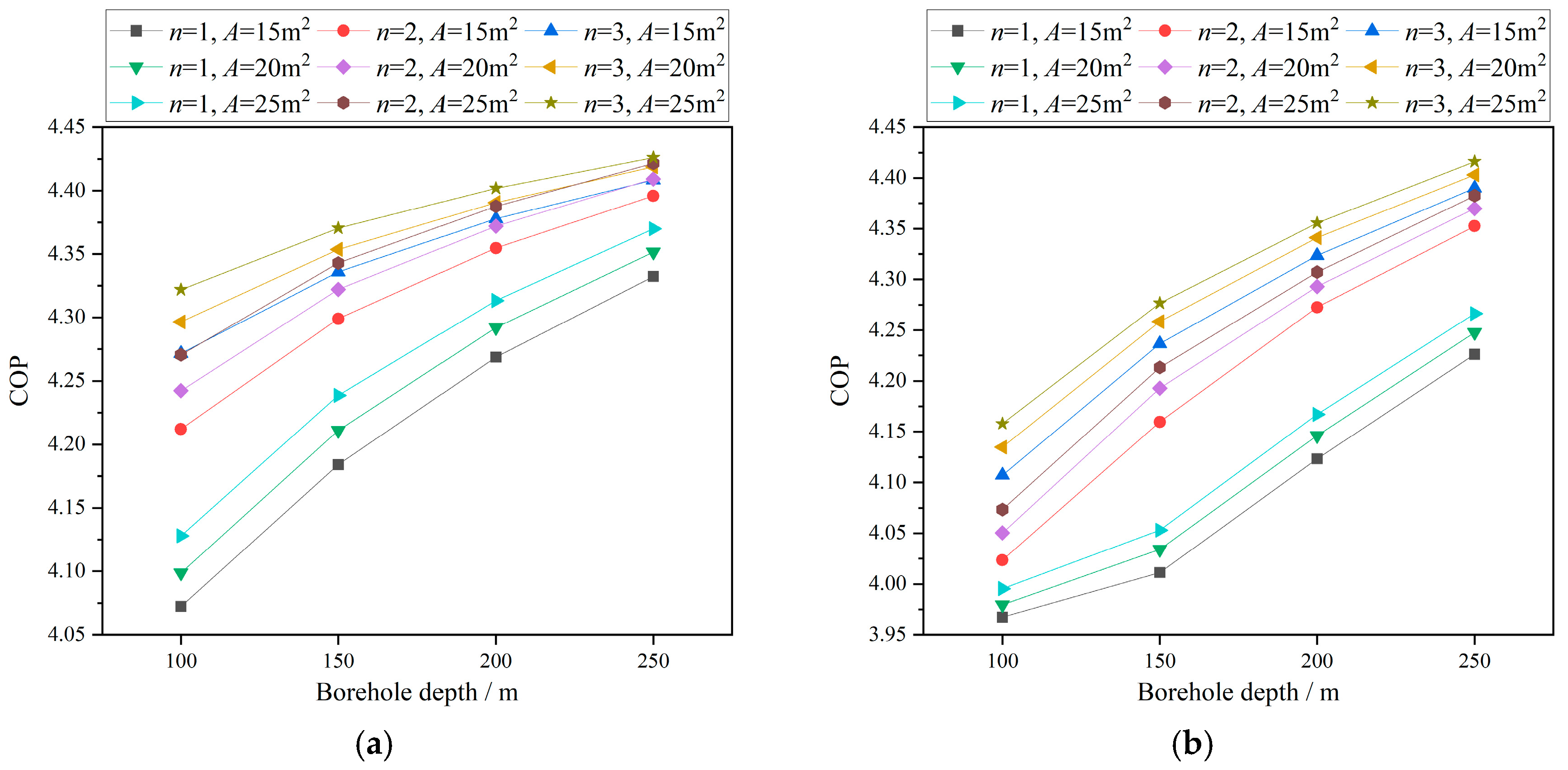


| Building Envelopes | Materials | Heat Transfer Coefficient (W·m−2·°C−1) |
|---|---|---|
| External walls | Cement mortar, bricks, insulation layer | 0.455 |
| External door | Exterior metal door | 3.150 |
| Ceiling | Reinforced concrete, cement mortar, composite roof panel | 0.579 |
| Windows | Low-E glazed | 2.52 |
| Component/TRNSYS Type | Parameters | Value 1 |
|---|---|---|
| Borehole heat exchanger/557a | Pattern | Single U-pipe |
| Number of boreholes | 2 | |
| Borehole spacing | 7 m | |
| Borehole depth | 150/200 m | |
| Borehole radius | 0.089 m | |
| Outer radius of pipe | 0.016 m | |
| Inner radius of pipe | 0.013 m | |
| Pipe thermal conductivity | 0.42 W·m−1·K−1 | |
| Fill thermal conductivity | 2.2 W·m−1·K−1 | |
| Rock–soil thermal conductivity | 1.80/2.12 W·m−1·K−1 | |
| Rock–soil heat capacity | 2420/1800 kJ·m−3·K−1 | |
| Thermal gradient | 0.0280/0.0394 °C/m | |
| Ground-source heat pump/225 | Rated heating power | 27.3/44.1 kW |
| Rated heating capacity | 6.5/10.5 kW | |
| Solar collector/165 | Collector slope | 50°/54° |
| Collector area | 15/20 m2 | |
| Domestic hot water tank/158 | Heat loss coefficient | 0.4 W·m−2·K−1 |
| Tank volume | 0.20/0.25 m3 | |
| Thermal storage tank/158 | Heat loss coefficient | 0.4 W·m−2·K−1 |
| Tank volume | 2/3 m3 |
| Beijing | Time periods | Electricity price, CNY/kWh |
| Peak pricing | 14:00~17:00, 19:00~22:00 | 0.9857 |
| Shoulder pricing | 8:00~14:00, 17:00~19:00, 22:00~24:00 | 0.6021 |
| Valley pricing | 0:00~8:00 | 0.3 |
| Changchun | Time periods | Electricity price, CNY/kWh |
| Peak pricing | 8:00~21:00 | 0.562 |
| Valley pricing | 21:00~8:00 | 0.329 |
| Component/TRNSYS Type | Parameters | Value 1 |
|---|---|---|
| Borehole heat exchanger/557a | Pattern | Single U-pipe |
| Number of boreholes | 2 | |
| Borehole spacing | 7 m | |
| Borehole depth | 150/200 m | |
| Borehole radius | 0.089 m | |
| Outer radius of pipe | 0.016 m | |
| Inner radius of pipe | 0.013 m | |
| Pipe thermal conductivity | 0.42 W·m−1·K−1 | |
| Fill thermal conductivity | 2.2 W·m−1·K−1 | |
| Rock-soil thermal conductivity | 1.80/2.12 W·m−1·K−1 | |
| Rock-soil heat capacity | 2420/1800 kJ·m−3·K−1 | |
| Thermal gradient | 0.0280/0.0394 °C/m | |
| Ground-source heat pump/225 | Rated Heating Power | 27.3/44.1 kW |
| Rated Heating Capacity | 6.5/10.5 kW |
| Beijing | H = 100 m, n = 2, A = 20 m2 | H = 150 m, n = 1, A = 25 m2 | H = 250 m, n = 2, A = 25 m2 | Control Group |
|---|---|---|---|---|
| Energy consumption, kWh | 49,035.78 | 43,350.22 | 46,822.96 | 101,578.70 |
| Heat extraction decay rate 1 | −0.39% | −0.45% | −0.52% | 0.51% |
| COP of GSHP | 4.24225 | 4.23859 | 4.42155 | 4.28314 |
| Initial investment, CNY | 38,000 | 31,000 | 88,750 | 49,500 |
| Operating electricity cost, CNY | 27,396.29 | 24,375.83 | 26,431.56 | 57,412.28 |
| Total cost, CNY | 65,396.29 | 55,375.83 | 115,181.56 | 106,912.28 |
| Changchun | H = 150 m, n = 2, A = 20 m2 | H = 150 m, n = 2, A = 25 m2 | H = 250 m, n = 1, A = 25 m2 | Control Group |
|---|---|---|---|---|
| Energy consumption, kWh | 128,747.32 | 116,659.97 | 113,558.05 | 184,221.23 |
| Heat extraction decay rate | 1.17% | 0.91% | 0.66% | 1.40% |
| COP of GSHP | 4.19286 | 4.21323 | 4.26632 | 4.26556 |
| Initial investment, CNY | 54,500 | 55,750 | 47,500 | 66,000 |
| Operating electricity cost, CNY | 56,326.95 | 51,213.73 | 50,249.44 | 81,591.58 |
| Total cost, CNY | 110,826.95 | 106,963.73 | 97,749.44 | 147,591.58 |
Disclaimer/Publisher’s Note: The statements, opinions and data contained in all publications are solely those of the individual author(s) and contributor(s) and not of MDPI and/or the editor(s). MDPI and/or the editor(s) disclaim responsibility for any injury to people or property resulting from any ideas, methods, instructions or products referred to in the content. |
© 2025 by the authors. Licensee MDPI, Basel, Switzerland. This article is an open access article distributed under the terms and conditions of the Creative Commons Attribution (CC BY) license (https://creativecommons.org/licenses/by/4.0/).
Share and Cite
Cao, Y.; Zhang, Z.; Jia, G.; Zhai, J.; Hao, J.; Zhang, M.; Jin, L. Performance Prediction and Analysis of Solar-Assisted Ground-Source Heat Pump Systems in Typical Rural Areas, China. Energies 2025, 18, 2208. https://doi.org/10.3390/en18092208
Cao Y, Zhang Z, Jia G, Zhai J, Hao J, Zhang M, Jin L. Performance Prediction and Analysis of Solar-Assisted Ground-Source Heat Pump Systems in Typical Rural Areas, China. Energies. 2025; 18(9):2208. https://doi.org/10.3390/en18092208
Chicago/Turabian StyleCao, Ying, Zhibin Zhang, Guosheng Jia, Jianyu Zhai, Jianke Hao, Meng Zhang, and Liwen Jin. 2025. "Performance Prediction and Analysis of Solar-Assisted Ground-Source Heat Pump Systems in Typical Rural Areas, China" Energies 18, no. 9: 2208. https://doi.org/10.3390/en18092208
APA StyleCao, Y., Zhang, Z., Jia, G., Zhai, J., Hao, J., Zhang, M., & Jin, L. (2025). Performance Prediction and Analysis of Solar-Assisted Ground-Source Heat Pump Systems in Typical Rural Areas, China. Energies, 18(9), 2208. https://doi.org/10.3390/en18092208








